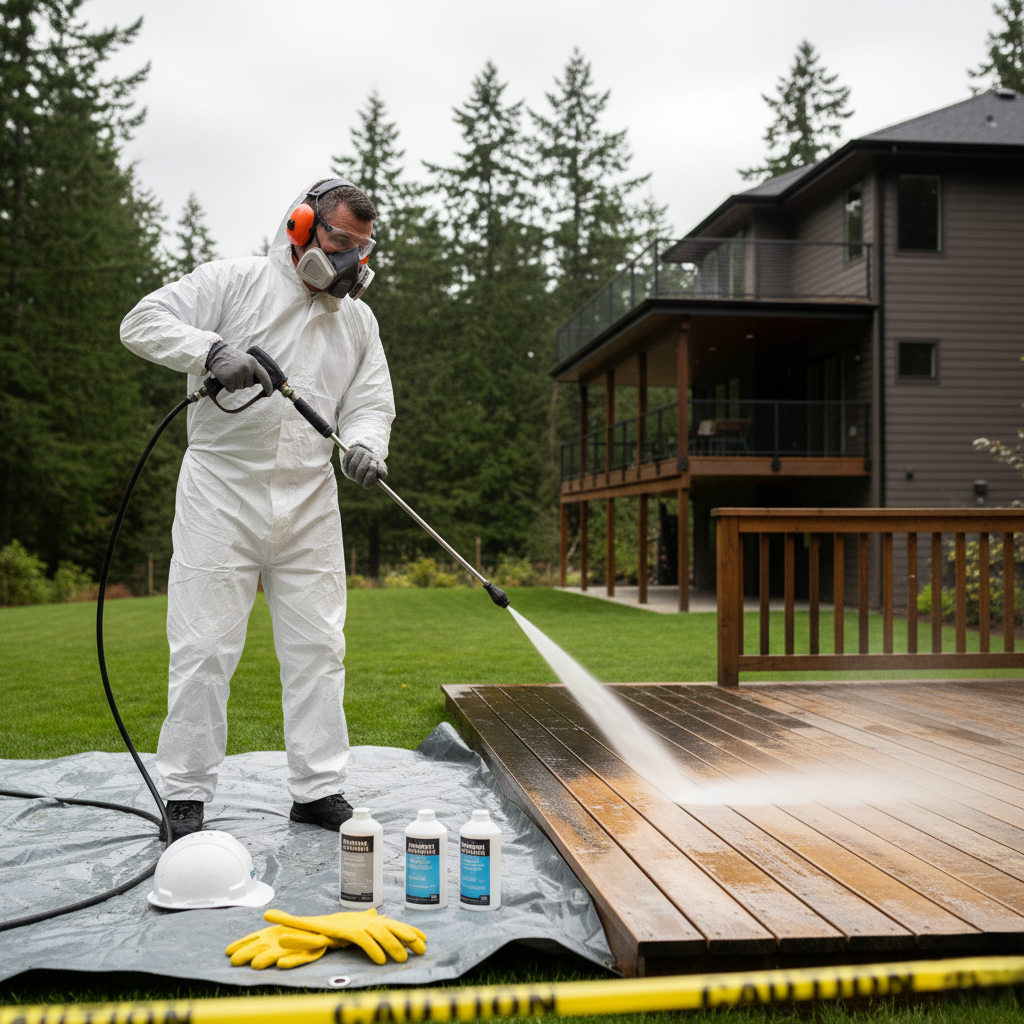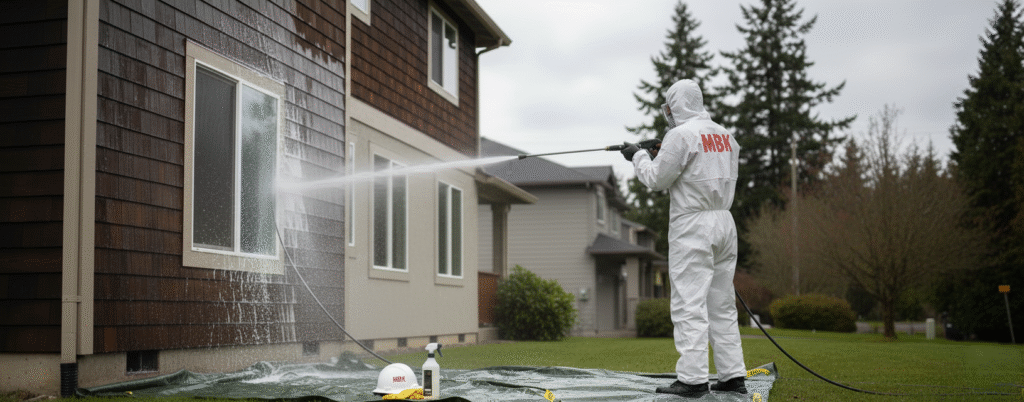Mold and mildew are more than just unsightly; they can damage your property and pose serious health risks if left untreated. In Portland, where the damp Pacific Northwest climate encourages fungal growth, these issues are especially common. Whether on siding, decks, driveways, or fences, mold and mildew thrive in shaded, moist areas that don’t dry out easily.
The good news is that pressure washing offers a powerful and eco-friendly way to remove mold and mildew from your property, if it’s done safely and correctly. In this guide, we’ll explain everything Portland homeowners need to know about safe pressure washing techniques, best cleaning solutions, and preventive maintenance tips to keep your property mold-free year-round.
Understanding Mold and Mildew in Portland’s Climate
Portland’s frequent rain, humidity, and mild temperatures make it the perfect breeding ground for mold and mildew. While mildew is a surface fungus that appears powdery and white or gray, mold tends to be darker (black, green, or brown) and can penetrate deeper into porous materials like wood or concrete.
Left untreated, these growths can:
- Eat away at wood and siding.
- Create slippery surfaces on decks and driveways.
- Trigger allergies, asthma, or respiratory issues.
- Lower your property’s curb appeal and resale value.
Why Pressure Washing Works for Mold and Mildew Removal
Pressure washing uses a stream of high-pressure water to lift dirt, grime, mold, and mildew from exterior surfaces. When performed correctly, it restores surfaces to their original condition without causing damage or using harsh chemicals.
Advantages of pressure washing for mold removal:
- Reaches deep into cracks and textures where mold spores hide.
- Removes years of built-up grime and organic growth in minutes.
- Safe for most surfaces when using the right pressure and nozzle.
- Environmentally friendly when used with biodegradable detergents.

Step-by-Step: How to Pressure Wash Mold and Mildew Safely
Step 1: Assess the Area
Start by inspecting the affected surfaces. Note the severity of mold growth, material type (wood, vinyl, brick, or concrete), and proximity to plants or windows.
This helps you choose the correct water pressure and detergent.
- Low-pressure (1,200–2,000 PSI): Ideal for wood, vinyl, and soft siding.
- Medium to high pressure (2,000–3,000 PSI): Works for concrete, brick, and stone.
Step 2: Protect Surrounding Areas
Cover windows, light fixtures, electrical outlets, and plants with plastic sheeting or drop cloths. Portland’s lush landscaping is worth protecting, so take time to safeguard greenery from detergent runoff.
Step 3: Apply an Eco-Friendly Cleaning Solution
Use a biodegradable mold and mildew remover formulated for pressure washers. Avoid chlorine bleach, which can harm plants, corrode metal, and discolor surfaces.
Instead, opt for solutions that use:
- Sodium percarbonate (oxygen bleach) – gentle but effective.
- Vinegar-based cleaners – great for small-scale mildew removal.
- Commercial eco-cleaners like Simple Green, Oxy Solve, or Wet & Forget Outdoor.
Apply the cleaner using the low-pressure detergent setting or a soap nozzle, then let it sit for 5–10 minutes to break down mold spores.
Step 4: Pressure Wash the Surface
Switch to a 15° or 25° nozzle and begin washing from top to bottom, keeping the wand about 12–18 inches away from the surface. Move in smooth, overlapping strokes to avoid streaks.
For stubborn spots, reduce distance slightly, but never closer than 6 inches, as this can cause etching or wood fiber damage.
Step 5: Rinse Thoroughly
Rinse away all cleaner residue with clean water. Detergent left behind can attract dirt or damage nearby plants. Make sure gutters and downspouts are clear so runoff drains properly.

Step 6: Allow Surfaces to Dry Completely
Mold and mildew love moisture. To prevent quick regrowth, allow surfaces to dry fully for at least 24 hours before applying sealants, paint, or stain.
Extra Tips for Safe and Effective Mold Removal
- Use safety gear: Always wear gloves, goggles, and a respirator when handling mold.
- Avoid ladders with pressure washers: Use an extension wand instead to prevent falls.
- Don’t overdo pressure: High PSI can damage siding or force water behind panels.
- Test first: Always test your pressure and cleaning solution on a small area before full application.
Preventing Mold and Mildew from Returning
Once your surfaces are clean, follow these maintenance tips to keep mold away:
- Trim back trees and bushes to let sunlight reach damp areas.
- Keep gutters clean to prevent water buildup near foundations.
- Use mold-resistant coatings or sealants on decks and siding.
- Pressure wash annually to remove early mold growth before it spreads.
For Portland’s humid climate, a preventive cleaning schedule every 6–12 months works best, especially after rainy seasons.
When to Call the Professionals
While DIY pressure washing can handle minor mold issues, large-scale growth or mold on multi-story buildings should be handled by professionals. Expert pressure washing teams in Portland have the right tools, cleaning agents, and experience to:
- Adjust PSI levels per surface type.
- Use commercial-grade mold inhibitors.
- Safely clean roofs, gutters, and hard-to-reach siding.
- Prevent damage to paint, stucco, or wood grain.
Hiring a licensed and insured Portland pressure washing service ensures your property is cleaned efficiently and safely — without risk to you or your home.
Eco-Friendly Practices for Portland Homeowners
Portland residents take pride in environmental responsibility, and pressure washing can be sustainable when done mindfully.
Eco-friendly pressure washing tips:
- Collect runoff when possible to avoid contaminating storm drains.
- Choose biodegradable detergents labeled non-toxic and phosphate-free.
- Avoid washing during heavy rain to minimize chemical spread.
- Dispose of wastewater responsibly following local city guidelines.
Final Thoughts: A Cleaner, Healthier Home Awaits
Pressure washing is one of the most efficient ways to remove mold and mildew from Portland properties, restoring surfaces, improving air quality, and protecting your home from decay. Whether you tackle it yourself or hire a professional, safety and preparation are key.
Call to Action
A well-maintained exterior not only looks great but also helps your property stand strong against Oregon’s damp weather. Regular pressure washing keeps your home beautiful, healthy, and ready for any season. Contact us today!



